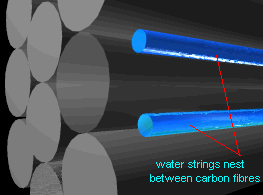|
|
Antipathy
between the water and carbon
causes 'water-strings' to spontaneously form centrally in each capillary.
Over short distances these water-strings will behave as efficient fibre
optics for any light introduced longitudinally at very shallow angles
of incidence.




|
At
the cut string end a short length of each water-string
will be expelled after priming. The properties of electrostatic antipathy, surface
tension and extant electromagnetic forces all bear upon the water to exit via
the cut string end but the end-meniscus formed at the break will be unable to
advance over the last few millimetres, where longitudinal antipathy becomes
massive relative to lateral pressure and a balance point occurs, keeping the
remainder of the water in each capillary.







